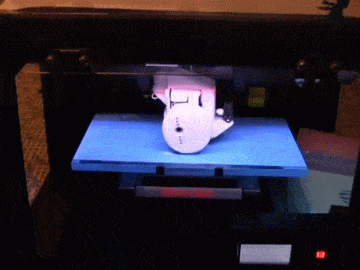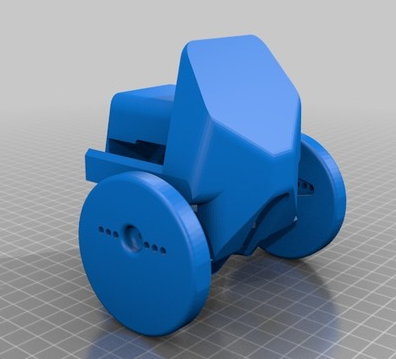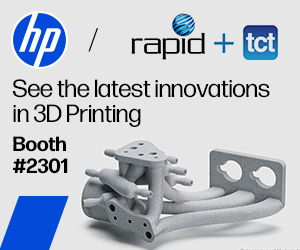This 3D Printed Robot Will Drive Itself Right Off Your Printer’s Build Platform Once Complete
 Although 3D printing may seem futuristic to us all now, in 5-10 years we will all likely be laughing at how rudimentary the technology really was. As investment capital continues to drive R&D within the space, and new materials are developed, 3D printers will become so much more than just tools for manufacturing inanimate objects. We have already seen the early stages of this transition with the launch of a company called Voxel8, and the pace of these changes will only continue to increase.
Although 3D printing may seem futuristic to us all now, in 5-10 years we will all likely be laughing at how rudimentary the technology really was. As investment capital continues to drive R&D within the space, and new materials are developed, 3D printers will become so much more than just tools for manufacturing inanimate objects. We have already seen the early stages of this transition with the launch of a company called Voxel8, and the pace of these changes will only continue to increase.
Yes, I truly believe that within the next decade a large portion of our electronics will literally be able to roll off the print bed and into use immediately; batteries, electronics and all. Whether this is accomplished via the printing of these components themselves or robotic systems which pick and place components during the print process, we will have to wait and see, but in the meantime one designer who goes by the name of Alex, is already pushing the limits of such technology and innovation.
Using a technique he calls ‘Coprocessing,’ Alex modifies his 3D print jobs mid-print by adding components by hand, then restarts the print job to encapsulate the components into the item he’s fabricating.
“I’ve used coprocessing in the past to generate some pretty fun things, but in my opinion this recent print has been the coolest,” Alex writes on his blog, Printeraction.
For his latest project, Alex set out to create a wheeled robot which literally drives itself off of the printer once it’s complete. The project begins on the build plate of his MakerBot Replicator 3D printer, where the bottom half of the robot is printed along with a covering piece that you will see printing to the right of the main body in the video  below. Once the first half of the robot is printed and the entire cover piece is done, Alex stops the print and adds in a variety of components which include an Arduino Mini, a long range Sharp IR sensor, 2 continuous rotation servo motors, and a battery box. He then removes the covering piece from the build platform, snaps it on top of the main body to compress all of the newly added components, and restarts the print.
below. Once the first half of the robot is printed and the entire cover piece is done, Alex stops the print and adds in a variety of components which include an Arduino Mini, a long range Sharp IR sensor, 2 continuous rotation servo motors, and a battery box. He then removes the covering piece from the build platform, snaps it on top of the main body to compress all of the newly added components, and restarts the print.
 The printer now finishes off the robot, encapsulating the components within. If you own a MakerBot Replicator, then you know that the build plate lowers as any print project progresses. This is where the IR sensor comes into play. Alex placed a piece of paper on top of the printer which allows the sensor he integrated into the robot to determine just how far down the build plate it sits. When it determines that it’s at the bottom, the motors activate, rotating the wheels, wrenching all the points of contact off of the build plate, as the robot rolls right off of the printer, quite literally.
The printer now finishes off the robot, encapsulating the components within. If you own a MakerBot Replicator, then you know that the build plate lowers as any print project progresses. This is where the IR sensor comes into play. Alex placed a piece of paper on top of the printer which allows the sensor he integrated into the robot to determine just how far down the build plate it sits. When it determines that it’s at the bottom, the motors activate, rotating the wheels, wrenching all the points of contact off of the build plate, as the robot rolls right off of the printer, quite literally.
“The printed robot is a fully integrated system, and it expands the definition of additive manufacturing and 3D printing to incorporate not just layers upon layers of material, but other systems and components as well,” Alex concludes.
Additional details about this project may be found at Alex’s blog as well as the Thingiverse model page. Let us know if you have ever tried any project similar to this. Discuss in the 3D Printed Robot forum thread on 3DPB.com. Check out the video of the entire project below.
Subscribe to Our Email Newsletter
Stay up-to-date on all the latest news from the 3D printing industry and receive information and offers from third party vendors.
Print Services
You May Also Like
3D Printing Grows to $15.9B in 2024 Amid Shifting Industry Dynamics
The global additive manufacturing (AM) market reached $15.9 billion in calendar year 2024, according to “Q4 2024 3DP/AM Market Data and Forecast” from Additive Manufacturing Research (AM Research). Despite a...
3DPOD 247: LJ Holmes, Executive Director for the Center of Advanced Manufacturing and Materials at Harrisburg University
Executive Director for the Center of Advanced Manufacturing and Materials at Harrisburg University, Larry “LJ” Holmes is a pioneer in applying additive manufacturing to defense and other critical sectors. Part...
Thai Startup OsseoLabs to Cut Surgery Time with 3D Printed Magnesium Implants
A patient undergoing mandibular reconstructive surgery typically faces two separate operations: one to place a custom-fit titanium plate and another month later to remove it. But what if that second...
Japanese Advanced Manufacturing Capabilities Grow in Europe with Sodick’s Purchase of Prima Additive
The global economy is currently undergoing a reshuffling in terms of what gets manufactured where. In large part, this trend is being driven by new geopolitical alliances and the need...


























